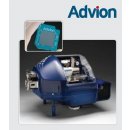应用领域:
资料类型:PDF
Rapid Commun Mass Spectrom. 2011 Dec 15;25(23):3587-96. doi: 10.1002/rcm.5274. Liquid extraction surface analysis mass spectrometry (LESA-MS) as a novel profiling tool for drug distribution and metabolism analysis: the terfenadine example. Eikel D1, Vavrek M, Smith S, Bason C, Yeh S, Korfmacher WA, Henion JD. Abstract
Liquid extraction surface analysis mass spectrometry (LESA-MS) is a novel surface profiling technique that combines micro-liquid extraction from a solid surface with nano-electrospray mass spectrometry. One potential application is the examination of the distribution of drugs and their metabolites by analyzing ex vivo tissue sections, an area where quantitative whole body autoradiography (QWBA) is traditionally employed. However, QWBA relies on the use of radiolabeled drugs and is limited to total radioactivity measured whereas LESA-MS can provide drug- and metabolite-specific distribution information. Here, we evaluate LESA-MS, examining the distribution and biotransformation of unlabeled terfenadine in mice and compare our findings to QWBA, whole tissue LC/MS/MS and MALDI-MSI. The spatial resolution of LESA-MS can be optimized to ca. 1 mm on tissues such as brain, liver and kidney, also enabling drug profiling within a single organ. LESA-MS can readily identify the biotransformation of terfenadine to its major, active metabolite fexofenadine. Relative quantification can confirm the rapid absorption of terfendine after oral dosage, its extensive first pass metabolism and the distribution of both compounds into systemic tissues such as muscle, spleen and kidney. The elimination appears to be consistent with biliary excretion and only trace levels of fexofenadine could be confirmed in brain. We found LESA-MS to be more informative in terms of drug distribution than a comparable MALDI-MS imaging study, likely due to its favorable overall sensitivity due to the larger surface area sampled. LESA-MS appears to be a useful new profiling tool for examining the distribution of drugs and their metabolites in tissue sections.
LESA-MS analysis Fixed tissue sections were placed onto a universal adapter plate, an optical image was obtained and the picture was calibrated for robotic sample location and sequence list generation using LESA Points Software (Advion Inc., Ithaca, NY, USA). The sample and adapter were then placed into a LESA-enabled TriVersa NanoMate robot (Advion Inc., Ithaca, NY, USA) without further sample processing and the selected areas were analyzed.




